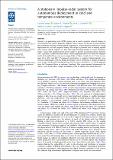Files in this item
A stationary impulse-radar system for autonomous deployment in cold and temperate environments
Item metadata
| dc.contributor.author | Mingo, Laurent | |
| dc.contributor.author | Flowers, Gwenn E. | |
| dc.contributor.author | Crawford, Anna J. | |
| dc.contributor.author | Mueller, Derek R. | |
| dc.contributor.author | Bigelow, David G. | |
| dc.date.accessioned | 2020-03-05T15:30:02Z | |
| dc.date.available | 2020-03-05T15:30:02Z | |
| dc.date.issued | 2020-02-17 | |
| dc.identifier | 266739016 | |
| dc.identifier | 5266df18-96fe-4c47-8087-302b27da611c | |
| dc.identifier | 85079848835 | |
| dc.identifier | 000565350800011 | |
| dc.identifier.citation | Mingo , L , Flowers , G E , Crawford , A J , Mueller , D R & Bigelow , D G 2020 , ' A stationary impulse-radar system for autonomous deployment in cold and temperate environments ' , Annals of Glaciology , vol. First View . https://doi.org/10.1017/aog.2020.2 | en |
| dc.identifier.issn | 0260-3055 | |
| dc.identifier.uri | https://hdl.handle.net/10023/19604 | |
| dc.description | L. Mingo acknowledges the SR&ED Tax Incentive Program of the CRA for offsetting some R&D costs of the sIPR. G. Flowers and D. Bigelow are grateful to NSERC, CFI, CSA, NSTP, PCSP and SFU for funding, Kluane First Nation, Yukon Government and Parks Canada for access to Yukon field sites and S. Williams, L. Goodwin, A. Pulwicki, J. Crompton,F. Beaud and Canadian astronaut D. Saint-Jacques for support and field assistance. C. Schoof and C. Rada provided time-lapse imagery and 2017 water-pressure data. A. Crawford and D. Mueller acknowledge funding from NSERC, Transport Canada, PKC/NSTP and the Garfield Weston Foundation, as well as support from Arctic Net, the CCGS Amundsen crew and pilots O. Talbot, A. Roy and G Carpentier. | en |
| dc.description.abstract | Stationary ice-penetrating radar (sIPR) systems can be used to monitor temporal changes in electromagnetically sensitive properties of glaciers and ice sheets. We describe a system intended for autonomous operation in remote glacial environments, and document its performance during deployments in cold and temperate settings. The design is patterned after an existing impulse radar system, with the addition of a fibre-optic link and timing module to control transmitter pulses, a micro-UPS (uninterruptable power supply) to prevent uncontrolled system shutdown and a customized satellite telemetry scheme. Various implementations of the sIPR were deployed on the Kaskawulsh Glacier near an ice-marginal lake in Yukon, Canada, for 44–77 days in summers 2014, 2015 and 2017. Pronounced perturbations to englacial radiostratigraphy were observed commensurate with lake filling and drainage, and are interpreted as changes in englacial water storage. Another sIPR was deployed in 2015–2016 on ice island PII-A-1-f, which originated from the Petermann Glacier in northwest Greenland. This system operated autonomously for almost a year during which changes in thickness of the ice column were clearly detected. | |
| dc.format.extent | 850136 | |
| dc.language.iso | eng | |
| dc.relation.ispartof | Annals of Glaciology | en |
| dc.subject | Arctic glaciology | en |
| dc.subject | Glacier hydrology | en |
| dc.subject | Glacier monitoring | en |
| dc.subject | Glaciological instruments and methods | en |
| dc.subject | Radio-echo sounding | en |
| dc.subject | GE Environmental Sciences | en |
| dc.subject | Earth-Surface Processes | en |
| dc.subject | NDAS | en |
| dc.subject.lcc | GE | en |
| dc.title | A stationary impulse-radar system for autonomous deployment in cold and temperate environments | en |
| dc.type | Journal article | en |
| dc.contributor.institution | University of St Andrews. School of Geography & Sustainable Development | en |
| dc.identifier.doi | 10.1017/aog.2020.2 | |
| dc.description.status | Peer reviewed | en |
This item appears in the following Collection(s)
Items in the St Andrews Research Repository are protected by copyright, with all rights reserved, unless otherwise indicated.

